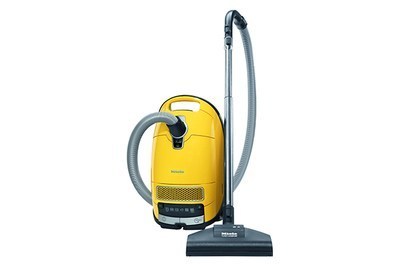We’ve Recommended Miele Canister Vacuums for Almost a Decade. Here’s Why They’re Worth It.

Christine Cyr Clisset is an editor overseeing home coverage. As a writer, she's tested blenders, food processors, sheet pans, and other kitchen gear.
Buying a good vacuum was one of those boring-but-necessary adulting chores (like going to the dentist or getting my car’s oil changed) that I knew I should do but kept putting off.
Frankly, I didn’t think I could afford one. I got by with a cheap vac that was heavy and loud, didn’t suck up anything all that well, and died within a few short years.
In 2014, with a toddler and two cats mucking up my apartment, I finally decided it was time to make the investment. I upgraded to a Miele canister vacuum, which Wirecutter began recommending that same year.
Nearly a decade later, I’ll never go back.
My old vacuum lugged around the apartment and roared like a motorcycle. By contrast, my Miele maneuvers elegantly around furniture, emitting a pleasant hum. It also cleans much, much better. The air feels cleaner, and there’s less dust. And there’s virtually none of that unwholesome grit that accumulates on the surfaces of New York City apartments.
Runner-up
This proven bagged model has great suction power and excels on bare floors and (most) area rugs. It works on most low-pile carpets but balks at thicker ones.
Why I love my Miele vacuum
Back in 2014, the Miele I purchased cost about $400 (the model has since been discontinued, but it has specs that are very similar to those of this Classic C1 Turbo.) I’ve had it going on ten years and will likely use it for another decade. Even with the cost of the replacement bags, that’s a much better value than a $300 vac that dies on me after a few years.
The robust filtration also turned out to be essential. When my second kid was about 18 months old, she developed rough, inflamed patches of eczema all over her arms and legs that she’d scratch bloody. We discovered she has a major dust mite allergy. At the time I had cheaped out (again! it’s a trend) and was using flimsy, off-brand vacuum bags. Once I switched back to Miele’s bags, her skin calmed way down. (Investing in HEPA air purifiers also helped.)
The reason Miele vacuums filter dust so well is that they use self-closing bags and rubber gaskets throughout the system, to keep dirty air from leaking out of the canister. You can also buy a HEPA filter for Miele vacs, but it’s likely worth it only for people with extreme asthma or allergies.
Miele sells over a dozen different bagged canister vacuums, ranging from roughly $400 to $1,800. You definitely don’t need the most expensive model. The one to get really depends on your floors. I have hardwoods and throw rugs, so I’m good with a basic model. I don’t even use the cleaning head for carpets. But if you do have carpets, you’ll probably want one with an air-powered turbo brush head, like the Complete C3 Calima, which we recommend as the runner-up in our guide.
All of the Miele canister vacuums basically have the same canister (though some are smaller or larger, and some seal a little better). After years of testing, we’ve found that the biggest differences between lower- and higher-end models are whether they have an electric or air-powered cleaning head, whether they have a crush-proof hose, and how you control the cleaning settings. To help you pick the best model for your needs, we recommend a few Miele canister vacuums in our guide, but they’re all good and here’s why:
- The build quality makes them light but strong. They’re impressively sturdy, without feeling clunky, and they rank among the quietest vacuums you can buy.
- Miele reps told us the company designs the motors to last for 1,000 hours, which equals roughly one hour per week for 20 years.
- Miele has a wider service network than other high-end vacs do.
- The filtration is excellent. If you or someone in your family has asthma, allergies, or any other condition affected by indoor air quality, Miele canister vacuums can measurably help (especially if you use the Miele bags).
One should note, though, that Miele reduced its warranty to three years for the Complete series (and one year for its Classic series) in 2020.
A long-term investment
By doing periodic maintenance—such as cleaning out clogs—you can help your Miele vac to keep running like new for years. Wirecutter has guidance on how to clean clogs and troubleshoot bigger problems with your vacuum.
Along with changing the bags once they’re full, you’ll also need to occasionally swap out the motor protector and exhaust filters. Miele bags come in boxes of four (along with filters). The company recommends changing the filters after you’ve cycled through four bags or (for some models) after a year.
If someone in your household has allergies, don’t be like me and cheap out on the bags. Miele’s are self-sealing and very thick—part of what makes the vacuums work so well. When I used thinner bags from a different brand, not only did my daughter’s eczema get worse, but I noticed there was a lot more dust and grit in my home. The Miele bags are expensive (usually around $22 for four), but they’re worth it if you need the full effect of the good filtration. If you need even more powerful filtration, you can also buy a HEPA filter.
I’m not the only Miele superfan at Wirecutter. A lot of my co-workers own these canister vacs and give them high praise (as do many of the industry experts we’ve talked with, including one from a competing brand!). If the price is holding you back, believe me, I get it. But when you’re finally ready to get the right tool for the job, investing in a Miele is totally worth it.
A version of this post was originally published as part of our 2020 “52 Things We Love” series, an ode to Wirecutter picks that have withstood the test of time. Read the entire series.
Meet your guide

Christine Cyr Clisset
Christine Cyr Clisset is a deputy editor overseeing home coverage for Wirecutter. She previously edited cookbooks and craft books for Martha Stewart Living Omnimedia, and she started reviewing kitchen gear back in 2013. She sews many of her own clothes, which has made her obsessive about high-quality fabrics—whether in a dress or bedsheets.
Further reading
The Best Vacuum Cleaners
by Sabine Heinlein
For a dependable, versatile, and affordable cleaner, we prefer a bagless upright, but we have recommendations for other types of vacuums as well.
The Best Robot Vacuums
by Sabine Heinlein
Robot vacuums never get bored or tired, so with little effort on your part, they can keep your floors consistently tidy.
What’s the Best Vacuum for Hardwood Floors?
by Sabine Heinlein
Any vacuum can clean bare floors, but some models make it a little easier. We think the Miele Classic C1 Pure Suction does an excellent job.
What’s the Best Vacuum for Pet Hair?
by Sabine Heinlein
We recommend six vacuums that have the tools, power, and maneuverability to tackle pet fur in your carpets, on your couch, or in your car.





